This building has always caught my eye. I used to think it was the Ashmolean Museum, but I know now that it is the Sheldonian Theatre. It was designed by Sir Christopher Wren in the 1660s. As shown in a previous post, it is used for Oxford graduation ceremonies. It is also used for concerts, lectures, and other university ceremonies. I've walked past this every single day that I've been here, and it always catches my eye, so I though, "Why not take a look inside?"
After many days of seeing this from the outside (and a previous trip seeing it only from the outside) - finally, a view from the inside!
I've seen so many pipe organs in so many places on this trip, even places like this where I wasn't expecting one. My soul is happy.
I wasn't expecting the ceiling to be so colorful! The theatre is full of symbolism, though I don't know what all of it means!Below is the motto of Oxford University: Dominus Illuminatio Mea ("The Lord is my light") from the opening words of Psalm 27.
Graduations were happening during various days when I was here (by college or by degree or by major, I'm not sure which, but relatively small groups at a time - one after the other), so the stage was set up.
After exploring the theatre pretty thoroughly, I made my way up to the cupola to see the view. The walk up was MUCH easer than that of the University Church tower climb!
The cupola has great views, though it does not have the full view of the Radcliffe Camera as the University Church tower does. On the other hand, this area here is quite spacious rather than cramped, and it is enclosed, which would be especially desirable on a rainy day. I hadn't realized until I went in and bought a ticket for a tour that you could climb up here, so for anyone else coming to Oxford, consider this a travel tip. :-)
Can you see the Bridge of Sigh's below?A view of Blackwell's Bookstore and a bit of the Weston Library from above.
And a couple of pictures of the view to the south, including the dome of the Radcliffe Camera.
If you'd like to see how all of this goes together, I have a minute-and-a-half-long video clip below. Beyond that we move to the next destination, which is the Merton College Campus - visited immediately after a (free) mid-day organ concert there.
Back to Merton College, which I covered in part in my post about Sunday (Divinity and Worship) - although with different pictures! My week had been so very full, so I thought about skipping this, despite how much I adore the organ and despite this having been on my calendar since before I left on this trip. Even in this glorious place, sometimes going from place-to-place-to-place, event-to-event-to-event, day-after-day-after-day gets wearing. Also, I normally appreciate the organ more as part of worship than in the context of a recital, but I'm so glad I didn't skip it. It was positively a taste of Heaven!
Merton holds free organ recitals every Thursday at 1:15pm. There were only about 18 people in the audience, yet the organist, Benjamin Sheen, was absolutely world class. He holds degrees in organ performance from Oxford and from Julliard. He's currently sub-organist at Christ Church Cathedral, Oxford. He regularly plays at international locations from Sweden to Australia to the US to Hong Kong and so on. It's just nuts that this unbelievable event was going on and that there were only about 18 people there to enjoy it!
Since I already posted a full complement of pictures from inside the chapel, the rest of the Merton pictures will be of the grounds. The picture above is the view as you leave the chapel, and below is the view looking back (chapel door on the left).
A view over Merton Field (where I saw cricket being played the previous day).
The gardens of Merton are just delightful!
This is definitely the most labyrinthine college I've visited - a new surprise around every corner. It is one of the oldest colleges at Oxford and may be the very oldest of the Oxford colleges, dating back to 1264. (Three Oxford colleges lay claim to being the oldest: Merton, Balliol and University College.)
A view over Merton Field (where I saw cricket being played the previous day).
The gardens of Merton are just delightful!
This is definitely the most labyrinthine college I've visited - a new surprise around every corner. It is one of the oldest colleges at Oxford and may be the very oldest of the Oxford colleges, dating back to 1264. (Three Oxford colleges lay claim to being the oldest: Merton, Balliol and University College.)
I completely lost track of how many quads this place has!!
Aside from some tiny anachronisms I could almost feel like I'd time-traveled back to the 1200s.
Not only can I absolutely not get enough of this place (as you can tell!), but a 16th-century mathematician that I'm interested in, Henry Briggs, lived and taught here, so I'm trying to get a sense of his surroundings. When the time comes to write my novel, I will need to sort out what actually was here in his time and what was not, but since I took pictures of EVERYTHING I know I have what I need, no matter what! (Believe it or not, I'm being very selective about what I post here, which is a mere fraction of the number of pictures I took.) Oh, and as long as I'm mentioning Merton profs, I should include non-mathematicians as well and also share that J. R. R. Tolkien was a Fellow of Merton. He was Professor of English Language and Literature here.
Above is a picture of the east end of the chapel. I think I've posted the picture below already, but I want to post it with the picture below it for the ability to compare and contrast the inside and outside of the easternmost stained glass window, which seems unique to those I've seen - especially how the stonework and stained glass are integrated.
To the right of the east window is a carving in the wall that may have been devised by Henry Briggs (or the Savillian Professor of Astronomy at his time, John Bainbridge). I initially thought this was a sundial, but it may be an instrument to measure the declination of the sun; I'm not sure. I was just happy to find it - had kept my eyes open for a carving on the chapel wall by Briggs that I had heard about, and this certainly fits one of the categories! It may have been by him, or it may have been by his colleague, but it goes back to his time.
Here it is in context as you look down the north side of the chapel:
And a look down Merton Street (to the east), as I exit the college:
Onward to the third major item of today, the famous, the historic: Turf Tavern. When I was here in 2016 I had no idea this place existed, and even up until just days before I left for the UK I had no idea this place existed. I became aware of it through watching travel vlogs on YouTube. It's become like yet another little treasure hunt - though not related to my mathematicians (as far as I am aware, given that it does date back to the 1100s, so it's possible they imbibed here at some point once upon a time).Can you see the entrance to the passage-way in the picture above? Look on the right. At the end of the red brick building there is a narrow opening between it and the building next to it. I took video, just over a minute long) of the path to get from here to the tavern. (In the video I am coming at it from the opposite side of the bridge.)Here is some information relating to this historic tavern - possibly the oldest on Oxford - originally built outside the city wall:
As well as posting here and keeping a written journal I was posting daily to facebook, and a friend who followed me there and saw the pictures I put up each time I peeked into this secret little spot kept asking, "Have you eaten there yet?" My answer was always "no." She said, "Well, at least sit down and get a glass of wine or something." This conversation went on for a few days, and though I didn't think I was going to, I finally did head over to actually sit down rather than just wander the cool hidden corridors. The best part was, believe it or not, standing in line. There I met a family from the US whose daughter was graduating from Oxford. We had a really great talk. It's always fun to connect with someone from "home" when you're far away.
This gave me a chance to relax and journal a bit. I was going to get dinner here as well, but the line was crazy-long, especially if you were ordering food rather than just getting a drink.
After this I continued to wander and explore. I'll just put up a very small selection of pictures from the rest of the day - including a C. S. Lewis/Narnia connection.
Continuing to wind around, I found what I recognized as the back of Queen's College Library, a library in which I had read back in 2016.
After a few more twists and turns I made my want back onto the High Street and over near University Church. Just beyond the west end of University Church, in St. Mary's Passage, is this doorway. (I feel like I've written about it already, but I THINK that was on facebook and not on this blog, so, hopefully this isn't a repeat.) Recently I read somewhere or maybe I heard somewhere - perhaps from a guide talking to a group of people near here that this was an inspiration to C. S. Lewis for his Narnia book The Lion, the Witch, and the Wardrobe. What immediately caught my attention was the image in the center of the door that does remind me of Aslan. It wasn't until I'd been standing there for a while that I noticed the fauns on either side above the door.
Also, just a bit to the north is a lamppost (center of picture).
Here too I took a video clip (less than a minute long) to put it in context:
I did do more wanderings this night - Brasenose Lane, Lincoln College, Covered Market, etc. - but I'm going to end with a photo of a place nearby the above - one of my favorite views in all Oxford.








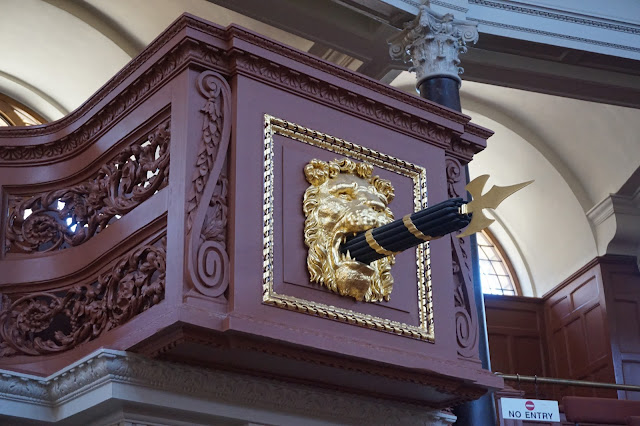























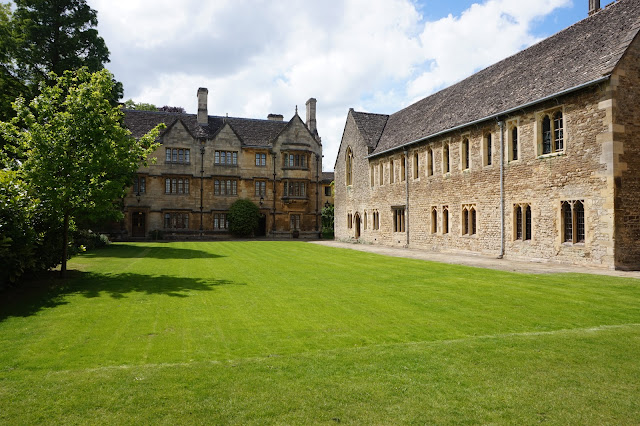

















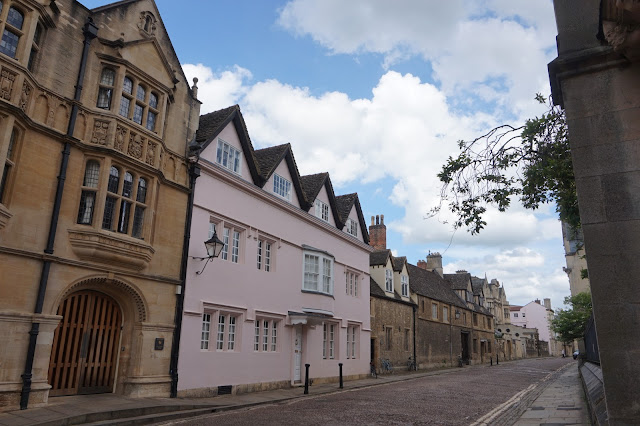









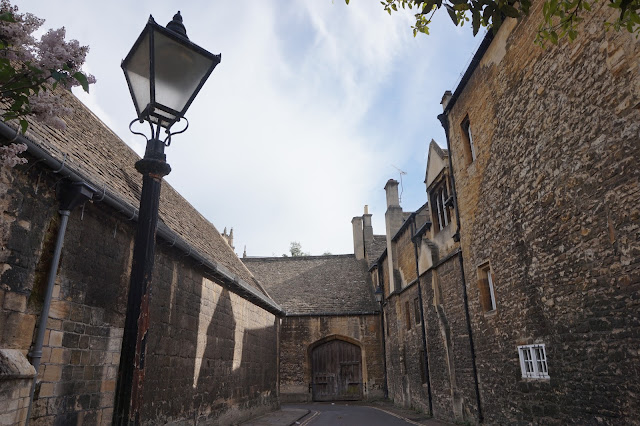


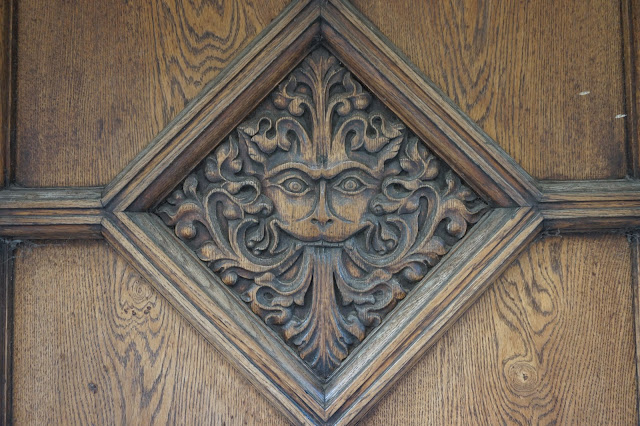


No comments:
Post a Comment